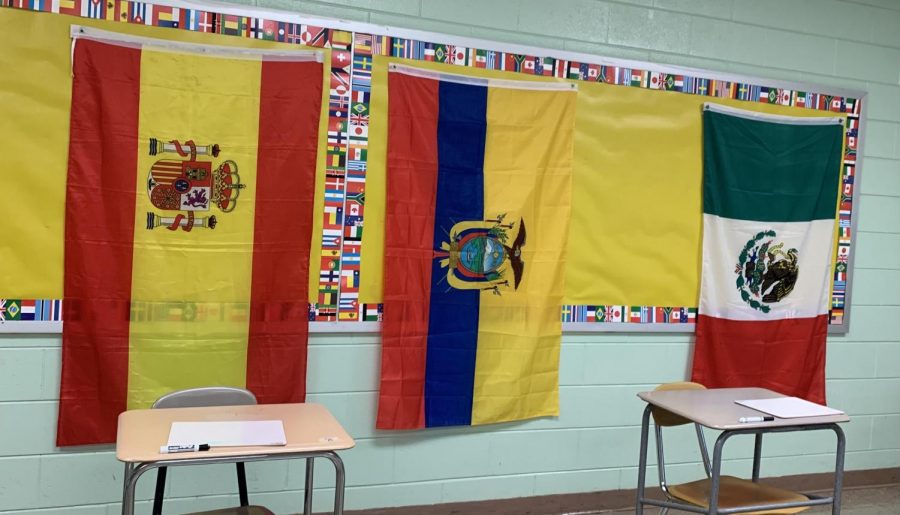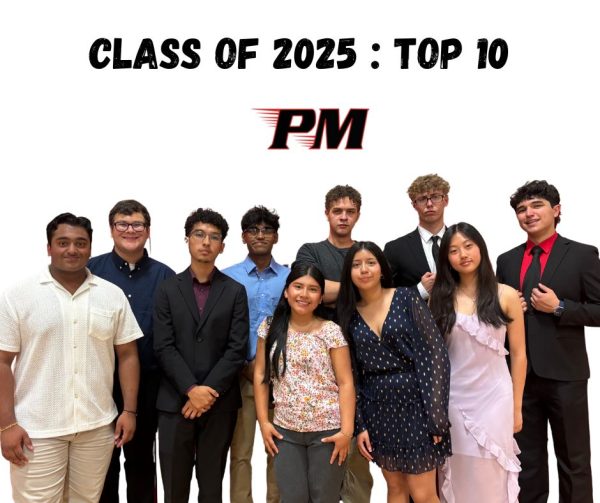What You Should Know About Hispanic Heritage Month
Photo by Daissy Pereira
Flags were hung all around the LOTE hallways during Hispanic Heritage Month.
This past month, Patchogue-Medford High School celebrated Hispanic Heritage from around the world. They celebrated it by hanging flags around the school, having a bulletin board in the same hallway as the school store and, announced some facts about different countries every morning!
I am personally half El Salvadorian, and I felt ecstatic when I heard my country on the morning announcements. I feel as if everyone learned something new about these countries this past month. I am going to provide you with even more facts you probably didn’t know about these countries. But before I begin, some people from Pat-Med High School gave me their opinions about Hispanic Heritage Month:
Social Studies teacher, Mr.Buccinna said, “I enjoy listening to the statistics and facts on the loud speakers each morning because it ties in with what I do in class”
English teacher, Mrs.Sbrocchi said, “I think it is great that our school celebrates this each year. In past years, the hallways have been covered in decorations and I’ve had students decorate my door for the month. I think it is always important to celebrate all the unique heritages that make up our school, but especially this year when so much is uncertain, divisive, and scary. It is a different school year for sure, so I’m not sure how many decorations or celebrations we will see as we have in the past, but just the fact that we hear the interesting facts each morning makes a difference and reminds us that above all, we must stand united.”
Mrs.Maleh said, “Being a Spanish teacher at Patchogue-Medford High School is an extremely rewarding job. Not only do I teach the language, but the curriculum also encompasses the various cultures and real life experiences of our Latin American population. I am so proud to work in a diverse community that embraces Hispanic Heritage Month. For many people, this is a month to celebrate their uniqueness and the strong ties to their language and traditions. It’s important for Americans, now more than ever, to be aware of the many diverse populations living in our country and to embrace their way of living. Hispanic Heritage Month celebrates the Spanish language as well as the many indigenous languages still spoken in Latin America, while also representing Portuguese which is spoken in Brazil. Hispanic Heritage Month celebrates the variety of dances, music, food, religions, and traditions that many identify with. It is a month to love and appreciate the impact that Latin American people have had on our country in regards to politics, entertainment, the arts, the sciences, and education. I can only hope that as a Spanish teacher I can instill the love and appreciation I have for our diverse group of Latinos, and that I can motivate students to become bilingual so that they are better prepared to make a difference in our global society.”
10th grader, Diago Angamarra said, “I like how the school celebrates Hispanic Heritage Month because there are immigrants that transfer here from different countries, and it gives them a sense of community when they come here.”
Another 10th grader, Olina Zheng, “I think that Hispanic Heritage Month is really important because it honors and recognizes the 21 different countries and gives you a sense of celebration of our differences.”
Senior, Jostine Zambrana said, “I feel like our school celebrating this event is crucial so every student and staff understands how many people come from different places and speak different languages, but we are all human. Being Hispanic is amazing because there are so many different cultures and when Pat-Med allows us to celebrate that we can share little pieces of our culture with others.”
10th grader, Briana Galarza said, “I like Hispanic Heritage Month because it’s a nice way to celebrate and appreciate Hispanic culture.”
11th grader, Ally Pedlar said, “I do enjoy how they take the time to talk about the different countries. I am fascinated with the different types of cultures and what they do in it.”
Thank you all for your messages, now let’s get on with the facts!
1) Why start on September 15th?
September Fifteenth was chosen as the starting point for the celebration of Hispanic Heritage Month because it is the anniversary of independence of five Latin American countries: Costa Rica, El Salvador, Guatemala, Honduras, and Nicaragua. In addition, Mexico and Chile celebrate their independence days on September 16th and on September 17th. I never really considered why this month was known as Hispanic Heritage Month, but it is very interesting now that I have understood the background of it and why we really celebrate it.
2) As America’s largest growing ethnic group, about 60 percent of people of Hispanic descent have type O blood compared to 45 percent of Caucasians and 50 percent of African Americans. Type O is the blood hospitals need most. It is very interesting knowing that there is a specific race that is more likely to have one blood type than the other!
3) With 329 million native speakers, Spanish ranks as the world’s No. 2 language in terms of how many people speak it as their first language. It is slightly ahead of English (328 million) but behind Chinese (1.2 billion) It is amazing how there are more Spanish speaking people than English! It would be amazing if one day it reached the same amount as China.
4) The term Hispanic was first adopted by the United States government in the early 1970s, and has since been used in local and federal employment, mass media, academia, and business market research. It has been used in the U.S. Census since 1980. Because of the popularity of “Latino” in the western portion of the United States, the government adopted this term as well in 1997, and used it in the 2000 census.
5) According to the 2010 Census, Hispanics accounted for more than half of the growth in United States population between 2000 and 2010. The U.S. is the fifth largest Hispanic country in the world. The majority of the U.S. population is Mexican American, followed in size by Central and South Americans, Puerto Ricans, and Cuban Americans. If we keep allowing other Spanish Speaking countries to come to the U.S., we can slowly but surely become the fifth largest Hispanic country in the world.
6) Hispanics are not a monolithic group. In some Hispanic subgroups have remarkably few characteristics in common. Various subgroups reflect great differences in ethnicity, culture, origin and can cover the racial spectrum, from white, African American, Asian, Pacific Islander and Native American. Hispanics are a mix of European, African and Native American people.
7) Mexicans comprise more than two-in-three Hispanics in the Los Angeles and Houston metro areas, reflecting their majority share among the national Hispanic population. But in many other metro areas, other origin groups make up the largest share among Hispanics. Puerto Ricans are the largest group in the Orlando, Florida, metro area, while Salvadorans are the largest in the Washington, D.C., metro area. Cubans are the largest origin group in the Miami metro area. I feel when people read a fact regarding this topic, it seems kind of frightening to them. Almost as if “Uh oh these people are taking over most of our populations, one day they’re going to take over America”. First, the people we think that it belongs too, does not belong to them. The land that was owned by the Native American’s almost 570 years ago were taken away from them, and under the Spaniards’ control. But even if there are people who want to come in and have a better life for themselves and their families should 100% be able to come without a problem. If you don’t like it, then do exactly what they did. If you don’t like OUR country and how it is evolving to become a better place, go somewhere else.
8) The Chicano movement was a civil rights movement that started by looking for the restoration of land grants. The movement expanded to encompass Mexican farm worker’s rights, enhanced education, voting rights and political rights. But these people should have been granted their rights the moment they set foot here. They do everything that other Americans do, such as work to put food on the table, to keep a roof over their head, to take care of their children, etc. They do everything they’re supposed too and yet it took them so long for them to be granted these rights.
9) The Georgia Hispanic Chamber of Commerce (ghcc.org) represents the interests of Hispanic businesses in the state. First established in 1994 as the Atlanta Hispanic Chamber of Commerce, the organization now has more than 1,300 members.
10) The Treaty of Guadalupe Hidalgo, signed February 2, 1848, ended the Mexican-American War. The United States agreed to pay Mexico $15 million. This agreement also included a territorial settlement in which the United States annexed the northern portion of Mexico, resulting in what is today Texas, New Mexico and California.
11) The terms Hispanic and Latino tend to be used interchangeably in the United States for people with origins in Spanish-speaking or Portuguese-speaking countries, like Mexico, Costa Rica, and Brazil. Contrary to many beliefs, Hispanic is not a race, but an ethnicity.
12) From 1998 to 1999 to 2008 to 2009, the number of associate’s degrees earned by Hispanics more than doubled (increasing by 101 percent) During the same time period, the number of bachelor’s degrees awarded Hispanic students increased by 85 percent.






